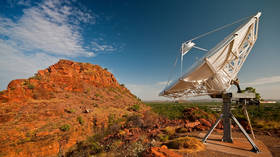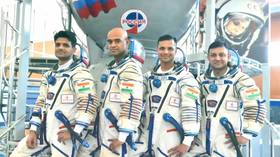31 Mar, 2024 03:26
Looking for aliens: Humanity unleashes AI and the largest ever telescope to search for life among the stars

Having joined up in January, India is set to be a key player among 16 nations in one of the 21st century’s grand scientific projects: humanity’s biggest-ever telescope. This confluence of radio astronomy and artificial intelligence (AI) will help observe the births and deaths of the first stars and search for habitable planets and extraterrestrial life.
The €2.2 billion ($2.4) Square Kilometer Array Observatory (SKAO) is an ambitious project whose 16 member nations also include South Africa, Australia, UK, Canada, China, France, Germany, Japan, Italy, the Netherlands, Portugal, South Korea, Spain, Sweden and Switzerland.
For this, India has set aside Rs 12.5 billion ($150 million) for a facility in Pune (156km east of Mumbai), a city abuzz with radio astronomy research activity. This facility will be a regional data center equipped with supercomputers to process the humongous amount of scientific data amassed by the telescope.
With the help of radio interferometry, astronomers can combine signals from many antennas or telescopes to create an image that is sharper and brighter than what would be possible from a single antenna dish. This technology effectively helps scan large swathes of the sky with radio telescope dish antennas spread many kilometers apart but functioning as a single observatory.
The global observatory, with thousands of units spread over two continents – in South Africa and in Western Australia – and its nerve center in a third continent, near Manchester, England, has thousands of scientists and engineers worldwide networking to develop innovative technologies. They will use SKAO to document cosmic data to fill 1.5 million laptops every year.
“The idea is to start training this year (using AI to decode scientific information) with approximately two petabytes of data archived through GMRT. We will use this to develop a small model demonstrating that India is ready to receive and analyze the data,” Prof Yashwant Gupta, director of the National Centre for Radio Astrophysics (NCRA) in Pune, told RT.
One component of the SKAO telescope is being built in South Africa’s Karoo region, the Northern Cape Province: an array of 197 traditional dish antennas separated by 150 km. The other half is an array of 131,072 two-meter-high Christmas-tree-like antennas in Western Australia separated by 65km. These sites were chosen far away from human habitation to prevent the disturbance of signals.
Six stations of the 'Array Assembly 0.5', on a remote site on the traditional lands of the Australian Wajarri Yamaji, were mounted on March 7. Components for the first six dish arrays at the Meerkat National Park in the arid Northern Cape, arrived at the end of February and efforts are underway to assemble them by the end of March.
SKAO will help understand the genesis of our universe, search for aliens or extraterrestrial intelligence (SETI), spot another potentially habitable world by identifying planets similar to ours, and pick up the birth pangs of new stars or the death throes of old ones millions of light-years away.
Astronomers worldwide estimate this observatory could pick up radio signals from every corner of the universe for at least 50 years from when it is launched in 2027-28. Radio waves, which all heavenly bodies emit, provide more accurate information than those carried by light (used by optical telescopes), which can be obstructed or diverted by dust, clouds, or rain.
This observatory will thus complement ongoing research with the help of optical telescopes and ones in space such as the James Webb Space Telescope and Hubble Space Telescope. The upshot is that it could throw up some serendipitous discoveries, too.
Most prominent of all, though, is the effort to unlock the secrets of the universe through the confluence of radio astronomy, whose foundations date back to the 1930s, and AI. The big data produced by SKAO will be an estimated 710 petabytes (a petabyte equals one quadrillion bytes, 1015) of information every year.
Leading the pack with the design of a prototype of a regional data center are Indian radio astronomers, who are set to use scientific evidence recorded by the Giant Metrewave Radio Telescope (GMRT) located near Pune in India.
Prof Gupta said Indian astronomers and engineers are set to play a critical role in producing the Observatory Monitor and Control System – the digital electronics required for signal processing at the facility in Western Australia – and developing software for the lion’s share of SKAO systems.
“Our research organizations and the industry will get an opportunity to design and produce world-class hardware required for SKAO,” he added.
The cue to turn to AI and other tools to learn from data to make predictions or identify heavenly bodies faster than humans perhaps originated from NASA Frontier Development Lab (FDL)’s partnership with big-ticket firms such as Microsoft, Google, IBM and Nvidia in Silicon Valley to solve problems in space science and forecast extreme weather in outer space for the prevention of blackouts or damage of satellites or harm to astronauts.
With the help of this collaborative effort, the computer model DAGGER (Deep Learning Geomagnetic Perturbation) has been developed to set off a warning 30 minutes in advance about solar storms that snap electricity distribution and communication networks in North America, Canada and other countries close to the polar region.
What’s more, this collaborative effort aids even in forecasting floods, Dr. Madhulika Guhathakurta, a renowned astrophysicist and Senior Adviser at NASA Heliophysics, told RT on the sidelines of an international conference hosted by the Astronomical Society of India in Bengaluru, last month.
She said at FDL, satellite images or data collected by the Solar Dynamics Observatory and telescopes in the past are made AI-ready to demonstrate the efficacy of forecasting Coronal Mass Ejection (CME), tons of red-hot dust, sometimes a million tons, from the sun that travel across interplanetary space at 3,000km a second towards all planets, scientific probes, satellites, and the earth.
“We need a large quantity of data archived from various sources to develop AI-based products,” she said. “Even auto-calibration of instruments onboard scientific observatories, which degrade over time, is possible with the combination of archived data and AI. It saves the cost of such auto-calibration of instruments, which otherwise could be done through the launch of suborbital rockets with similar instruments. Virtual instruments, too, can be created in space as a replacement for either damaged or malfunctioning sensors with the coming together of astronomers and computer experts.”
Sci-fi or unfolding reality? Interdisciplinary teams of scientists and domain experts in AI are set to accelerate discoveries of new habitable worlds, aliens, and new organisms existing in interplanetary space besides rolling out products for applications like the early forecast of storms in space and on Earth, among others, with this combination of old data and AI tools.


